Trees Birds Mammals Fish Amphibians Reptiles
Wild Algarve
Bookshop
Agaricus urinascens (F.H. Møller & Jul. Schäff.) Singer - Macro Mushroom
Phylum: Basidiomycota - Class: Agaricomycetes - Order: Agaricales - Family: Agaricaceae
Distribution - Taxonomic History - Etymology - Identification - Culinary Notes - Reference Sources
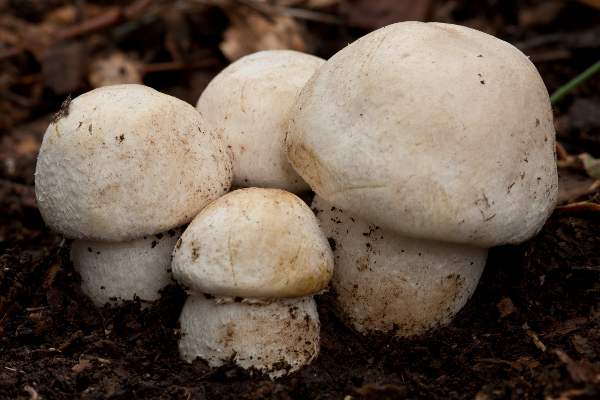
Agaricus urinascens is one of Britain and Ireland's rare to occasional 'true mushrooms' (a term that many mycologists apply to Agaricus species).
Distribution
Agaricus urinascens occurs throughout Britain and Ireland and can also be found in other mainland European countries from northern Scandinavia right down to the Mediterranean region.
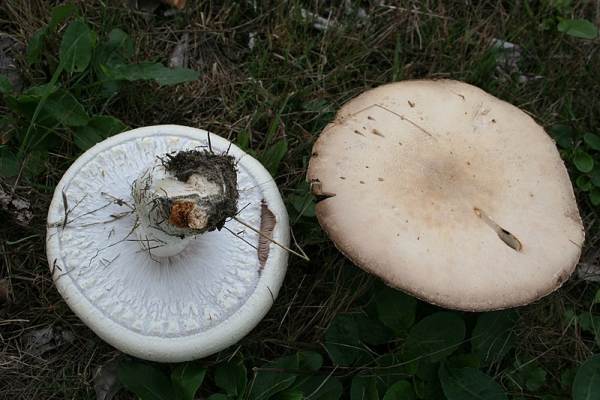
Taxonomic history
A thoroughly modern mushroom, this species was described scientifically in 1938 by Danish mycologist Frits Hansen Møller (1887 - 1962) and German mycologist Julius Schäffer (1882 - 1944), when it was given the binomial scientific name Psalliota urinascens. (The Psalliota genus has since been subsumed within Agaricus.)
The scientific name Agaricus urinascens dates from a 1949 paper (published in 1951) by German-born American Rolf Singer.
Two varieties of this species are now recognised, and so the nominate variety is formally referred to as Agaricus urinascens var. urinascens. (Agaricus urinascens var, excellens is a very rare species, at least in Britain; it occurs in woodlands.)
The picture immediately above is by Strobilomyces (Own work) CC-BY-SA-3.0 or GFDL, via Wikimedia Commons.
Synonyms of Agaricus urinascens var. urinascens include Psalliota villatica, Psalliota arvensis ssp. macrospora F.H. Møller & Jul. Schäff., Psalliota urinascens F.H. Møller & Jul. Schäff., Agaricus macrosporus (F.H. Møller & Jul. Schäff.) Pilát, Agaricus urinascens (F.H. Møller & Jul. Schäff.) Singer, Psalliota macrospora (F.H. Møller & Jul. Schäff.) F.H. Møller, and Agaricus albertii Bon.
This mushroom is referred to in many recently-published field guides as Agaricus macrosporus.
Etymology
The specific epithet urinascens means 'gradually acquiring a smell like urine', while the common English name Macro Mushroom is a reference to the huge size (compared with other mushrooms in the Agaricus genus) of the spores of these mushrooms.
Identification guide
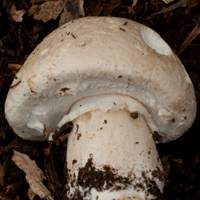 |
Cap
Initially globose, the
cap of Agaricus urinascens expands to become plano convex and eventually flattens without an in-rolled margin, and the surface is radially fibrillose or scaly at maturity, white at first but becoming pale ochre and yellowing slightly, especially near the margin, when bruised. Caps grow to between 10
and 25cm diameter at maturity. When bruised, the cap surface slowly turns yellowish, most noticeably towards the margin. |
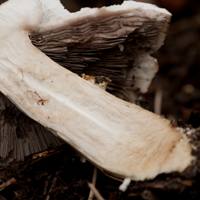 |
Gills
Pale greyish pink when young, the crowded free somewhat undulating gills later become dark brown or purplish brown as the fruitbody ages. The gill edges are slightly paler than the gill faces.
Stem
The stem is 2 to 3.5cm in diameter and 7 to 12 cm long, fusiform to cylindrical with a
slightly clavate base and a pendent membranous ring, the lower surface patterned like a cog wheel. Above the ring the stem surface is smooth, while below it is girdled with white or slightly brownish scales in a rather irregular snakeskin-like pattern. When cut the stem flesh turns slightly brown,
most markedly at the stem base. |
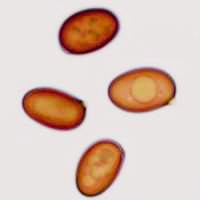 |
Spores
Ellipsoidal, smooth, 8.5-12.3 x 5.2-6.9µm - larger than the spores of any other Agaricus species found in Britain.
Spore print
Brown. |
Odour/taste |
When young the Macro Mushroom gives off a faint but pleasant smell of almonds, but as the fruitbody ages its smell becomes increasingly ammoniacal (or like urine, as its specific epithet suggests). The taste is very like that of the familiar commercial button mushroom (the cultivated form of Agaricus bisporus). |
Habitat & Ecological role |
Macro Mushrooms are saprobic and are most commonly seen in small groups in permanent pastures, on grassy roadside verges, on woodland edges and in grassy woodland clearings. |
Season |
Early July to late October in Britain and Ireland. |
Similar species |
Agaricus arvensis, the Horse Mushroom, initially has a similar white cap but at maturity it takes on a more yellowish hue; its spores are much smaller than those of Agaricus urinascens (and it smells less unpleasant in old age!).
Agaricus osecanus is similar but with rather smaller spores; it smells of crushed almonds even when mature and is a much rarer find in Britain and Ireland. |
Culinary Notes
The Macro Mushroom is a good edible species and can be used in any recipe calling for large cultivated (Portobello) mushrooms. It is great in risotto dishes and omelettes, and it makes tasty soups and sauces to be served with meat.
Reference Sources
Fascinated by Fungi, 2nd Edition, Pat O'Reilly 2016, reprinted by Coch-y-bonddu Books in 2022.
BMS List of English Names for Fungi
The genus Agaricus in Britain, 3rd Edition, self-published, Geoffrey Kibby 2011
Funga Nordica: 2nd edition 2012. Edited by Knudsen, H. & Vesterholt, J. ISBN 9788798396130
Dictionary of the Fungi; Paul M. Kirk, Paul F. Cannon, David W. Minter and J. A. Stalpers; CABI, 2008
Taxonomic history and synonym information on these pages is drawn from many sources but in particular from the British Mycological Society's GB Checklist of Fungi.
Acknowledgements
This page includes pictures kindly contributed by David Kelly.
Top of page...
Fascinated by Fungi. Back by popular demand, Pat O'Reilly's best-selling 450-page hardback book is available now. The latest second edition was republished with a sparkling new cover design in September 2022 by Coch-y-Bonddu Books. Full details and copies are available from the publisher's online bookshop...